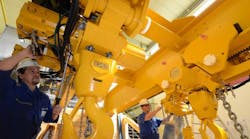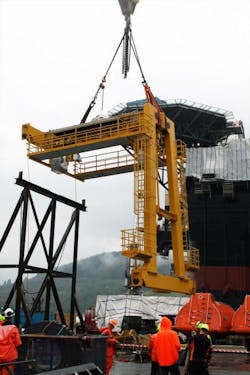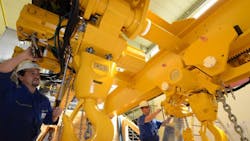Hydraulics are the power behind the largest crane system constructed to date by J D Neuhaus. The crane system was delivered to Westcon Lofteteknikk AS (WCL) of Norway for use on an offshore drilling rig. The semi portal design comprises an A-frame supporting twin overhead horizontal track beams providing a 7.5-m span.
The crane has an approximate height of 11.5 m with a total weight of 32 ton. It is equipped with JDN hydraulic EH 40-H monorail hoists operating on each of the twin beams, each hoist providing an individual lift capacity of 40 ton. These hoists can be operated individually or simultaneously from one control, and when used together, can lift a total of 80 ton with 12-m lift height. A JDN Profi 6 TI-H hoist with 6 ton lift capacity covers other operational or service requirements.
The whole energy supply system, which was designed and manufactured by JDN, incorporates four hydraulic drives provided for the crane travel movements. An electro-hydraulic switch cabinet is also mounted on the access gangway. The primary radio crane controls also have a back-up system fitted to cover any radio control panel failure. Manual operation is available to cover any unscheduled loss or failure of the electric power supply.
The crane complies with offshore operation, at temperatures down to -20ºC. Survival conditions can also be maintained in the event of inclines from the horizontal of the rig of 3º with the crane loaded or 27º when unloaded. It allows operation in potentially hazardous environments with an Ex-Classification of Ex II 3 GD IIB T4. A special safety feature covesr any disruption to or total loss of the main power supply. This feature comprises a back-up hydraulic pump with fluid reservoir tank to provide emergency lowering of suspended loads, together with safe positioning of both hoist trolleys and crane.
he design, manufacture and performance of the crane comply with relevant standards and regulations including:
• 2006/42/EC – EC Machine directive,
• DNV OS E101 – drilling plant,
• DNV lifting appliances 2.22,
• FEM 1-001 – rules for design of hoisting appliances, and
• Norsok R-CR-002 – lifting equipment.
Westcon Lofteteknikk AS (WCL) is an authorized Norwegian sole importer of J D Neuhaus lifting and handling equipment.
Contact Peggy Weber at [email protected] or visit www.jdneuhaus.com for more details.



